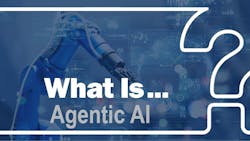Agentic AI is a budding technology that boasts autonomy and workflow independence, one that is different from traditional artificial intelligence (AI). It can help streamline operations and prevent malfunctions on the plant floor, with the potential to enhance other manufacturing processes. This article explores the details, differentiators, possible drawbacks and indications for the future of Agentic AI in manufacturing.
What is Agentic AI?
Agentic AI is an advanced AI system that can work autonomously to make self-directed decisions based on multiple inputs, acting on these decisions in organized steps that require little to no human intervention.
Although Agentic AI adapts to individual scenarios, these are the high-level processes it follows:
- Agentic AI can draw information from various digital databases and physical environments to understand the situation and formulate a plan to accomplish a directive.
- The reasoning engine, typically run from a Large Language Model (LLM), is the heart of Agentic AI. This engine uses predictive analysis to evaluate all possible scenarios based on available information, and then choose a plan of action based on its directive and contexts.
- Agentic AI will proceed with its chosen plan, often broken down into organized subtasks, to accomplish a high-level objective.
- Finally, the system is self-improving. Agentic AI continuously learns and improves from its past decisions to enhance future outcomes in what is referred to as a “data flywheel.”
In a maintenance environment, Agentic AI continuously monitors machinery health and analyzes performance data. Thus, it can detect abnormal temperature signatures, early signs of wear, or energy spikes to forecast a machine breakdown before it occurs. The AI system then makes real-time operational adjustments to correct the machine’s functions before a total shutdown occurs. This reduces machine downtime, human intervention, and maintenance costs, while extending the lifetime of equipment to enhance operations.
Agentic AI can also autonomously maximize throughput in supply chain contexts, rather than optimizing fixed schedules as traditional AI would. By shifting resource allocation to optimize production, identifying alternative materials, and reconfiguring logistics in the event of a supply chain disruption, Agentic AI can be used to fully automate decisions under dynamic conditions.
What are the risks associated with Agentic AI?
There are various challenges associated with Agentic AI:
- Agentic AI is a developing technology. Thus, it is difficult to predict its long-term effectiveness in complex situations. “Most agentic AI propositions lack significant value or return on investment, as current models do not have the maturity and agency to autonomously achieve complex business goals or follow nuanced instructions over time,” according to Anushree Verma, Senior Director Analyst at Gartner.
- Agentic AI adoption is more complicated than a plug-and-play system. 65% of companies lack the data infrastructure to run Agentic AI systems, according to Lucidworks. Providing Agentic AI with siloed data and limited visibility leads to a failure to deliver adequately contextualized solutions.
- Governance inadequacies are another cause for concern. Agentic AI systems may violate company policies, operational regulations or risk barriers when they are not trained on company-specific data.
Is Agentic AI the next big thing for maintenance?
Despite risks to deployment and the infancy of the technology, Agentic AI has potential in the manufacturing industry to “enhance manufacturing resilience, efficiency, and adaptability,” according to a study from Cornell University. In 2022, McKinsey & Company forecasted that Agentic AI will reduce machine downtime by 30 to 50%, increase throughput by 10 to 30% and deliver 85% more accurate forecasting.
Its applications and apparent positive returns within the manufacturing industry make it a compelling avenue for future application. 25% of surveyed manufacturing companies will see the application of Agentic AI within at least one facet of operation in the upcoming 12 months, according to a study conducted by Capgemini in 2025. Another 28% of the manufacturing industry will see Agentic AI integration in the upcoming 1-3 years.
Careful adoption of these systems is just as important as the encouraging numbers, according to Kaur. Ensuring teams are well-versed in applied AI tools, integrating legacy systems with Agentic insights, and teaching Agentic AI models to navigate company-specific data according to policy are all key to fostering collaboration with this new technology.
What are the differences between Agentic AI and Generative AI?
Differences between Agentic AI and generative AI are vast. Dr. Jagreet Kaur, Founder of Akira AI and former Head of Artificial Intelligence for XenonStack identifies the key differences. The information table is courtesy of XenonStack, with added examples from ChatGPT behavior.
|
Feature |
Generative AI (Eg. ChatGPT) |
Agentic AI |
|
Behavior |
Reactive - ChatGPT operates based solely on user prompts |
Proactive and autonomous |
|
Focus |
Solves isolated tasks - ChatGPT does not possess full memory retention across sessions |
Manages workflows end-to-end |
|
Decision-Making |
Uses predefined rules - ChatGPT operates within model specs established by OpenAI |
Learns and adapts in real-time |
|
Execution |
Suggests actions for humans - ChatGPT can make suggestions or answer prompts |
Takes independent actions where applicable |
About the Author
Maya Schwartz
Maya is a rising junior at Northwestern University, where she studies journalism and environmental engineering, along with a minor in business. She brings experience in technical writing, environmental consulting, and research-driven publishing, with a passion for bridging the gap between technical innovation and accessible communication.
